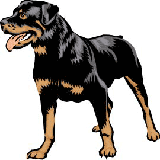Big DogsInformation About The Great Dane Dog Breed |
|
|
History and origin : The Great Dane has been in Britain for many centuries and may have resulted from a cross between the ancient Mastiff and the Irish Wolfhound. He was first used as a hunting and guarding dog. Description : The Great Dane is a large, elegant breed, standing 30 to 34 inches at the shoulder and weighing between 120 and 165 pounds. The harlequin Danes, white with black patches, are the largest variation, whereas the brindle and fawn-colored Danes are more slender. The black Danes and the blues are usually somewhere in between. The ears can be cropped or uncropped. The body is massive, lanky, and well muscled, and the shedding coat is short, glossy, and of low maintenance, requiring regular brushing. The color may be black, black-and-white (harlequin), bundle, fawn, or blue-black. About the breed : The Great Dane is a very devoted and affectionate family dog. However, he can be very suspicious of strangers and is very territorial and often aggressive toward other dogs or people. The dog would love your children, but might be suspicious of their friends. Also, he is capable of hurting a child during play, just by knocking them down, stepping on them, or hitting them with his tail. Training should start early and should be firm but not overbearing. All giant breeds mature slowly; a six-month-old will be huge but will still have the mind of a puppy. Training technique should still be firm and a bit slower and less demanding than that used with other breeds. The Great Dane gets cold easily, so do not keep him outside too long during the winter. He needs a blanket or a bed to lie on to prevent pressure sores. He has an excellent sense of smell but below-average eyesight. He has a life span of about eight or ten years. Many Danes have congenital heart problems as well as hip and shoulder problems. The Dane also has a habit of splitting open the tip of his big tail because of wagging it with such enthusiasm that, when smacked against a hard surface, will split open and bleed. He can suffer from bloat, a fatal gastric condition that can occur after a large meal. Avoid feeding him and other large breeds huge meals and thoroughly soak the dry food in warm water for ten minutes before feeding. Feeding : Recommended feeding for the Great Dane is 4 cans (13.3oz) of high-quality meaty product with biscuit added or at least 5 cupfuls of a complete dry dog food. A Great Dane will eat eight to twelve cups of food a day. Ideal home : A Great Dane needs a large house with a big yard with a fence at least six feet high. The owner of a Dane should be a physically strong, confident, and easygoing leader. Physically weak, nervous, and spoiling types should avoid this breed, as should the elderly and the disabled. The Dane can be very dog-aggressive and needs strong leadership and socialization with people and other dogs from day one. No roughhousing should be allowed. Time to exercise this giant breed must be available everyday. Back to the Big Dog Breed article page
| |
|
Related News About Dogs ' ); // get rid of newsfeed display by carp CarpConf('poweredby',''); CarpCacheShow('http://classifieds.agriscape.com/syndicate/dogs.rss'); ?>
|
|
|
|
|
|
Copyright © 2006-2007 dogguidance.com |


